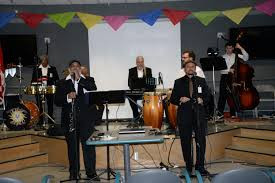Salsa dancing, with its infectious energy and passionate movements, is a skill many aspire to learn. At ten-dance.com, we believe everyone can master the basics and experience the joy of salsa. This guide explores the realistic timelines for learning salsa, offering tips and resources to accelerate your progress and connect you with fellow dance enthusiasts. Let’s explore the world of salsa dance styles, learning resources, and local dance communities!
1. What Determines How Long It Takes to Learn Salsa Dancing?
The time it takes to learn salsa dancing varies, depending on your goals, experience, dedication, and learning approach. According to research from the Juilliard School, consistent practice and focused instruction dramatically accelerate skill acquisition in dance.
1.1. Desired Proficiency Level
Are you aiming to navigate a social dance floor comfortably, perform impressive moves, or become a professional salsa dancer? Your ambition dictates the journey’s length.
- Beginner (Social Dancer): To enjoy salsa at parties and social gatherings, you’ll need basic steps, turns, and partnering skills.
- Intermediate Dancer: This involves complex combinations, styling, musicality, and improvisation.
- Advanced/Professional Dancer: Expect extensive training, mastering multiple salsa styles, performance skills, and possibly teaching abilities.
1.2. Previous Dance Experience
Prior dance experience, even in other genres, can provide a solid foundation for learning salsa. Understanding rhythm, body awareness, and coordination can shorten the learning curve.
- No Prior Experience: Start with fundamental steps and rhythms.
- Some Dance Experience: You might grasp basic salsa steps quicker.
- Extensive Dance Background: You may advance rapidly and focus on nuances and styling.
1.3. Time Commitment
The more time you dedicate to learning, the faster you’ll progress. Consistent practice reinforces muscle memory and improves technique.
- Casual Learning (1-2 hours/week): Progress is slower but steady.
- Dedicated Practice (3-5 hours/week): Faster improvement and skill development.
- Intensive Training (5+ hours/week): Rapid advancement towards higher levels.
1.4. Learning Style and Resources
Your learning environment significantly impacts your progress. Choose methods that suit your style and provide quality instruction.
- Group Classes: Affordable, social, and good for learning basic steps.
- Private Lessons: Personalized attention, tailored feedback, and faster progress.
- Online Courses: Convenient, flexible, and offer a wide range of styles and levels.
- Social Dancing: Practice in real-world settings, improve improvisation, and gain confidence.
2. Realistic Timelines for Learning Salsa Dancing
While individual progress varies, here’s a general timeline for reaching different proficiency levels in salsa dancing.
2.1. Salsa in One Week: Is It Possible?
Learning salsa in a week is ambitious, requiring total immersion and intense effort. According to a study from the American Dance Therapy Association, intensive dance programs can improve physical and mental well-being in a short period.
- Degree of Difficulty: Extremely challenging.
- Commitment: Full dedication with multiple lessons and practice sessions daily.
- Expected Outcome: Learn basic steps and simple patterns, enough to move to the music.
- Learning Activities: Multiple private lessons, group classes, and dance parties.
- Focus: Mastering basic steps, timing, and partner connection.
- Tips: Find an experienced instructor for focused guidance.
- Challenges: High risk of burnout and difficulty retaining information.
2.2. Salsa in One Month: A Focused Approach
Learning salsa in a month is more realistic with a focused approach and consistent effort.
- Degree of Difficulty: Challenging but achievable.
- Commitment: Consistent lessons and practice, staying focused on goals.
- Expected Outcome: Learn several combinations and execute basic turns and spins.
- Learning Activities: 2-3 private lessons per week, group classes, and social dancing.
- Focus: Refining basic techniques, learning simple combinations, and improving musicality.
- Tips: Supplement salsa lessons with Merengue to refine moves and turns.
- Challenges: Requires discipline and consistent effort to avoid forgetting steps.
2.3. Salsa in Six Months: Building a Solid Foundation
Six months allows for a more relaxed pace, enabling you to build a solid foundation and develop good habits.
- Degree of Difficulty: Moderate, allowing time for integration and refinement.
- Commitment: Regular lessons and practice, with time for social dancing and exploration.
- Expected Outcome: Confidently lead or follow a variety of patterns, understand musicality, and develop personal style.
- Learning Activities: Weekly lessons, regular social dancing, workshops, and online resources.
- Focus: Mastering fundamental techniques, exploring different salsa styles (e.g., LA, New York, Cuban), and developing styling.
- Tips: Attend workshops to learn from different instructors and styles.
- Challenges: Staying motivated and consistent over an extended period.
2.4. Salsa in One Year: Mastering the Dance Floor
One year provides ample time to master salsa, developing a smooth, fluid style and enjoying the dance fully.
- Degree of Difficulty: Leisurely, allowing for deep understanding and enjoyment.
- Commitment: Consistent but relaxed learning, enjoying the process and social aspects.
- Expected Outcome: Become an accomplished social dancer, comfortable with various partners and musical styles.
- Learning Activities: Regular classes, frequent social dancing, attending congresses and festivals, and exploring related dance styles.
- Focus: Refining technique, mastering advanced patterns, developing improvisation skills, and exploring other Latin dances (e.g., Bachata, Merengue).
- Tips: Immerse yourself in the salsa scene by attending events and connecting with other dancers.
- Challenges: Avoiding complacency and continuously seeking new challenges.
3. Speeding Up Your Salsa Learning Journey
While time is a factor, there are ways to accelerate your salsa learning and make the most of your efforts.
3.1. Set Realistic Goals
Define what you want to achieve and break it down into smaller, manageable steps. This helps you stay motivated and track progress.
- Short-Term Goals: Learn a specific step or combination each week.
- Mid-Term Goals: Be comfortable dancing salsa at social events within a few months.
- Long-Term Goals: Perform at a showcase or become a proficient dancer in a year.
3.2. Consistent Practice
Regular practice is crucial for developing muscle memory and reinforcing what you’ve learned. Aim for short, frequent sessions rather than long, infrequent ones.
- Daily Practice: Even 15-30 minutes of practice can make a difference.
- Practice with a Partner: This helps you develop leading and following skills.
- Record Yourself: This allows you to identify areas for improvement.
3.3. Find a Good Instructor
A qualified instructor provides structured guidance, personalized feedback, and helps you avoid developing bad habits.
- Experience and Credentials: Look for instructors with proven experience and a strong reputation.
- Teaching Style: Choose an instructor whose teaching style aligns with your learning preferences.
- Personal Connection: Find an instructor you connect with and feel comfortable asking questions.
3.4. Immerse Yourself in the Salsa Scene
Attending social dances, workshops, and festivals exposes you to different styles, dancers, and music, accelerating your learning and expanding your network.
- Social Dancing: Practice in real-world settings and learn from experienced dancers.
- Workshops: Learn from various instructors and explore specialized topics.
- Festivals: Immerse yourself in the culture and community of salsa dancing.
3.5. Cross-Training
Complement your salsa training with activities that improve your fitness, flexibility, and coordination.
- Yoga: Enhances flexibility, balance, and body awareness.
- Pilates: Strengthens core muscles and improves posture.
- Cardio: Improves stamina and endurance for dancing.
4. Overcoming Challenges in Learning Salsa
Learning salsa can be challenging, but addressing common obstacles can keep you motivated and on track.
4.1. Lack of Confidence
Many beginners feel self-conscious about their dancing. Focus on progress, not perfection, and celebrate small victories.
- Start Slow: Begin with basic steps and gradually build up to more complex moves.
- Practice in a Safe Environment: Dance with supportive friends or in a comfortable class setting.
- Focus on Enjoyment: Remember that salsa is about having fun, not being perfect.
4.2. Coordination and Timing
Developing coordination and timing takes time and practice. Break down complex moves into smaller steps and focus on rhythm.
- Practice Basic Steps: Master the fundamental steps before moving on to more complex patterns.
- Listen to the Music: Pay attention to the rhythm and try to internalize the beat.
- Use a Metronome: Practice with a metronome to improve timing.
4.3. Finding a Partner
Having a regular partner can accelerate your learning, but it’s not essential. Focus on developing your skills and being open to dancing with different people.
- Take Partnering Classes: Learn the fundamentals of leading and following.
- Attend Social Dances: Meet new people and practice with different partners.
- Be Open to Dancing with Anyone: Don’t be afraid to ask someone to dance, regardless of their skill level.
 Salsa dancing at night
Salsa dancing at night
5. The Benefits of Learning Salsa Dancing
Beyond the joy of dancing, learning salsa offers numerous physical, mental, and social benefits.
5.1. Physical Health
Salsa dancing is a great workout that improves cardiovascular health, strength, and flexibility.
- Cardiovascular Health: Improves heart health and endurance.
- Strength and Endurance: Strengthens muscles and increases stamina.
- Flexibility and Coordination: Enhances flexibility, balance, and coordination.
5.2. Mental Well-being
Dancing releases endorphins, reduces stress, and improves mood. It also enhances cognitive function and memory.
- Stress Reduction: Reduces stress and anxiety.
- Mood Enhancement: Elevates mood and promotes happiness.
- Cognitive Function: Improves memory, focus, and cognitive function.
5.3. Social Connections
Salsa dancing is a social activity that connects you with like-minded people and expands your social circle.
- Meet New People: Connect with fellow dancers and make new friends.
- Build Relationships: Form lasting relationships through shared experiences.
- Community Involvement: Become part of a vibrant and supportive dance community.
6. Exploring Different Salsa Styles
Salsa has evolved into various styles, each with its unique characteristics and flavor. Exploring different styles can broaden your dance vocabulary and enhance your appreciation for the dance.
6.1. L.A. Style Salsa
Known for its flashy, acrobatic moves and emphasis on performance, L.A. style is popular in clubs and showcases.
- Characteristics: Linear style, with dancers moving along a slot.
- Focus: Showmanship, with intricate footwork, spins, and dips.
- Music: Typically danced to fast-paced, energetic salsa music.
6.2. New York Style Salsa
Elegant and sophisticated, New York style emphasizes timing, precision, and partner connection.
- Characteristics: Danced on the “2” beat, with a focus on musicality and control.
- Focus: Smooth, fluid movements and intricate partner work.
- Music: Often danced to classic salsa and mambo music.
6.3. Cuban Style Salsa (Casino)
Social and playful, Cuban style is characterized by its circular movements and improvisational nature.
- Characteristics: Circular style, with dancers moving around each other.
- Focus: Fun, social interaction, and improvisational steps.
- Music: Typically danced to Cuban salsa music, also known as “Timba.”
6.4. Colombian Style Salsa (Cali Style)
Fast-paced and energetic, Colombian style is known for its rapid footwork and intricate patterns.
- Characteristics: Fast footwork and intricate patterns.
- Focus: Precision, speed, and agility.
- Music: Danced to fast-paced Colombian salsa music.
7. Essential Salsa Steps for Beginners
Mastering the basic steps is crucial for building a solid foundation in salsa dancing.
7.1. Basic Step
The foundation of all salsa dancing, the basic step involves shifting your weight between your feet while maintaining a rhythmic pulse.
- Description: Step forward, backward, or to the side, then recover and repeat on the other side.
- Tips: Maintain a slight bend in your knees and keep your core engaged.
7.2. Side Basic
Similar to the basic step, but moving side to side, the side basic helps develop balance and coordination.
- Description: Step to the side, recover, and repeat on the other side.
- Tips: Keep your weight balanced and avoid leaning too far to one side.
7.3. Cross Body Lead
A fundamental turn pattern, the cross-body lead involves the lead guiding the follow across their body.
- Description: The lead steps forward, guides the follow across their body, and then steps to the side.
- Tips: Maintain a clear lead and follow connection.
7.4. Right Turn
A classic turn pattern, the right turn involves the lead guiding the follow to turn to their right.
- Description: The lead initiates the turn by lifting their hand and guiding the follow to turn.
- Tips: Keep the follow balanced and avoid pulling or pushing them.
8. Finding Salsa Classes and Events Near You
Connecting with local salsa communities and resources can enhance your learning experience.
8.1. Local Dance Studios
Many dance studios offer salsa classes for all levels. Look for studios with experienced instructors and a welcoming atmosphere.
- Research: Read reviews and ask for recommendations.
- Trial Classes: Take a trial class to see if the studio is a good fit.
- Location and Schedule: Choose a studio that is convenient and offers classes that fit your schedule.
8.2. Social Dance Events
Attending social dances is a great way to practice your skills and meet other dancers.
- Check Local Listings: Look for salsa nights at clubs, bars, and community centers.
- Online Communities: Join online groups and forums to find events.
- Ask Your Instructor: Your instructor can recommend social dance events in your area.
8.3. Salsa Festivals and Congresses
Salsa festivals and congresses offer intensive workshops, performances, and social dancing.
- Research: Look for festivals and congresses in your region or travel to attend larger events.
- Plan Ahead: Book tickets and accommodations in advance.
- Network: Connect with instructors and dancers from around the world.
9. Essential Gear and Resources for Salsa Dancing
Having the right gear and resources can enhance your learning and practice experience.
9.1. Dance Shoes
Proper dance shoes provide support, flexibility, and traction, making dancing more comfortable and safe.
- Suede Soles: Provide the right amount of slip and grip on the dance floor.
- Comfortable Fit: Choose shoes that fit well and provide adequate support.
- Heel Height: Select a heel height that you are comfortable with.
9.2. Dance Attire
Wear comfortable clothing that allows you to move freely.
- Breathable Fabrics: Choose fabrics that wick away moisture and keep you cool.
- Fitted Clothing: Avoid baggy clothing that can get in the way.
- Layers: Dress in layers so you can adjust to the temperature of the dance floor.
9.3. Online Resources
Numerous online resources offer salsa tutorials, music, and information.
- YouTube Channels: Many channels offer free salsa lessons and tutorials.
- Online Courses: Structured courses provide comprehensive instruction.
- Music Streaming Services: Create playlists of your favorite salsa music to practice with.
10. Common Questions About Learning Salsa Dancing (FAQ)
Here are some frequently asked questions about learning salsa dancing:
10.1. Is Salsa Hard to Learn?
Salsa can be challenging initially, but with consistent practice and proper instruction, anyone can learn to dance.
10.2. Do I Need a Partner to Learn Salsa?
No, you don’t need a partner to start learning salsa. Many classes and social events have rotating partners.
10.3. What is the Best Age to Start Learning Salsa?
There is no best age to start learning salsa. People of all ages can enjoy and benefit from dancing.
10.4. How Often Should I Practice Salsa?
Aim to practice at least 2-3 times per week to see consistent improvement.
10.5. What Should I Wear to a Salsa Class?
Wear comfortable clothing that allows you to move freely. Dance shoes are recommended but not required for beginners.
10.6. How Can I Improve My Musicality in Salsa?
Listen to salsa music regularly, pay attention to the rhythm and instruments, and try to internalize the beat.
10.7. What is the Difference Between Leading and Following in Salsa?
Leading involves guiding the follow through the dance, while following involves responding to the lead’s cues.
10.8. How Can I Find a Good Salsa Instructor?
Look for instructors with experience, a strong reputation, and a teaching style that aligns with your learning preferences.
10.9. What Are Some Common Mistakes Beginners Make in Salsa?
Common mistakes include poor posture, stiff movements, and not listening to the music.
10.10. How Can I Stay Motivated While Learning Salsa?
Set realistic goals, celebrate your progress, and find a supportive dance community.
Ready to embark on your salsa journey? Visit ten-dance.com for comprehensive guides, online lessons, and a vibrant community to support your dance aspirations. Whether you’re looking for local classes, event listings, or a place to connect with fellow dancers, ten-dance.com is your ultimate resource. Start dancing and experience the joy of salsa today! Address: 60 Lincoln Center Plaza, New York, NY 10023, United States. Phone: +1 (212) 769-7000. Website: ten-dance.com.


